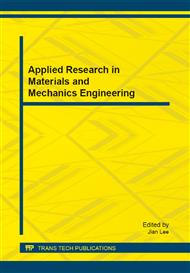[1]
Barthlott W, Neinhuis C. Purity of the sacred lotus or escape from contamination in biological surfaces [J]. Planta, 1997, 202: 1-8.
DOI: 10.1007/s004250050096
Google Scholar
[2]
Neinhuis C, Barthlott W. Characterization and distribution of water-repellent, self-cleaning plant surface. Annals of Botany, 1997, 79: 667-677.
DOI: 10.1006/anbo.1997.0400
Google Scholar
[3]
Ren Lu-quan, Chen De-xing, Hu Jian-guo. Initial analysis on the law of reducing adhesion of soil animals[J]. Transactions of the Chinese Society of Agricultural Engineering. 1990(1): 15~20.
Google Scholar
[4]
Fang Yan, Sun Gang, Wang Tong-qing, Cong Qian, Ren Lu-quan. Non-smooth morphology hydrophobicity mechanism on butterfly wing surface. Chinese Science Bulletin. 2007(3): 354~357.
DOI: 10.1007/s11434-007-0120-5
Google Scholar
[5]
Ren Lu-quan, Shang Guang-rui, Yang Xiao-dong. Influence of typical poultry feather structure and surface lipoid on wettability [J]. Journal of Jilin University (Engineering and Technology Edition), 2006, 36(2): 213~218.
Google Scholar
[6]
Mittal, K, L. Contact angle, wettability and adhesion; VSP: Utrecht, The Netherlands, (1993).
Google Scholar
[7]
R. Blossey, Nat, Mater. 2003, 2, 301.
Google Scholar
[8]
X. Gao, L. Jiang, Nature 2004, 432. 36.
Google Scholar
[9]
Nakajima, A. Eujishima, A. Hashimoto.T. Adv. Mater. 1999, 11, 1365~1368.
Google Scholar
[10]
Yoshimitsu, Z. Nanajima, A. Watanabe, T. Langmuir 2002, 18, 5818~5822.
Google Scholar
[11]
Patankar, N. A. Langmuir 2003, 19, 1249.
Google Scholar
[12]
Mamdouh E. Abdelsalam, Philip N. Barlett, Timothy Kelf, and Jeremy Baumberg. Wetting of Regularly Structured Gold Surfaces. Langmuir2005, 21(5): 1753~1757.
DOI: 10.1021/la047468q
Google Scholar
[13]
Jessica Pacifico, Kohei Endo, Stephanie Morgan, and Paul Mulvaney. Superhydrophobic Effects of Self-Assembled Monolayers on Micropatterned Surfaces: 3-D arrays Mimicking the Lotus Leaf. Langmuir, 2006, 22, 11072~11076.
DOI: 10.1021/la060925d
Google Scholar
[14]
Lee, W. Nanostructured Metal Surface Fabricated by a Non-lithographic Template Method. Langmuir, 200420(2): 287~290.
Google Scholar
[15]
Wenzel R.N. Ind. Eng. Chen. 1936, 28, 988~994.
Google Scholar
[16]
Cassie A.B.D. Baxter, S. Trans. Faraday. Soc. 1944, 40, 546~551.
Google Scholar


